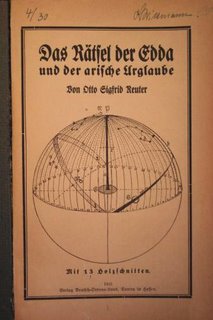In 1917, a book with strange and uncanny tales that bore the remarkable title
Lemuria was published in Germany. The horrible blackness and the almost pathological nature of its haunting illustrations closely connected to the spirit of the German nation, as the fatherland was desperately struggling to survive the onslaught that was the First World War.
Lemuria struck a chord in the German psyche and was reprinted well till after the Great War that should have ended all wars, but didn't.
The name
Lemuria was introduced in the 19th century by geologists speculating on a lost continent in the Indian ocean. The term was quickly seized upon by occultists and theosophists in the wake of Blavatsky's unveilings.
Blavatsky saw the Lemurians as reptilian in nature, being the Third Root Race, having followed the Hyboreans, The Second Root Race. However, the Lemurians used black magic and corrupted themselves by intermingling with other species, necessitating the gods of destroying Lemuria after which they created the Fourth Root Race, that of Atlantis. One notes the origin of much current speculation on the reptilians, but also the influence on Ariosophy. The nucleus of Blavatsky's theories on Lemuria are similar to those of
Lanz von Liebenfels, founder of the Ordo Novi Templi, an order modelled partially on The Knights Templar. Liebenfels also edited the antisemitic periodical
Ostara of which it is claimed that an impressionable Adolf Hitler read these during his years in Vienna.
In
Lemuria we encounter one short story, entitled
Der Bogomilenstein (The Stone of the Bogomil), that may betray some of Strobl's cultural predilections. The Bogomils were spiritual forerunners of the Cathars and, some say, the Knights Templar. German author Hanns Heinz Ewers wo would later write the National-Socialist anthem the
Horst Wessel Lied published
Lemuria in a series titled
Gallerie der Phantasten (Gallery of the Fantasts) with publisher Georg Muller Verlag in Munich. The author of
Lemuria was Austrian writer
Karl Hanns Strobl (1877 - 1946), who during his life also was
the editor of Der Orchideengarten, about which I posted earlier on this blog
.
Strobl wrote many unusually dark, strange and gruesome fantastic tales, collected in, amongst others,
Lemuria and, For instance, his book
Od that was released in 1930. 'An adventure-romance of Baron von Reichenbach. A Zeileis-fate 50 years ago. The discovery of the magical man', it's blurb read.
During the First World War , Strobl was a messenger, a position not unlike that of his fellow Austrian Adolf Hitler. After the war, Strobl developed a strong sympathy for the Nationalsocialist cause. In 1938 Strobl worked in an important position in the Ostgau, leading a department of Goebbel's
Reichsschrifttumskammer. This lead to his arrest by the Soviet troops in 1945. Strobl was forced to work at road construction for a while. He was released due to age and very poor health.
Impoverished, Strobl died a year later in a home for the elderly near Vienna. At the time of his death, the Allied forces had prohibited his works to be published. Once his more than hundred published book titles commanded multiple reprints and huge successes. Strobl formed, with Gustav Meyrink and Hanns Heinz Ewers the three dark princes of the German horror and supernatural.

































